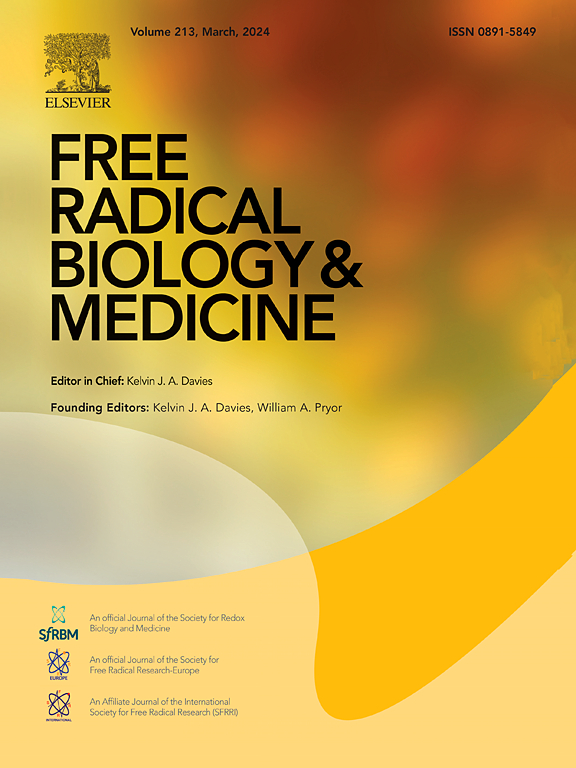Selenium supplementation protects cancer cells from the oxidative stress and cytotoxicity induced by the combination of ascorbate and menadione sodium bisulfite
IF 7.1
2区 生物学
Q1 BIOCHEMISTRY & MOLECULAR BIOLOGY
引用次数: 0
Abstract
The combination of ascorbate (vitamin C) and menadione sodium bisulfite (MSB, vitamin K3), here called VC/VK3 (also named Apatone®, or M/A), has shown selective cytotoxicity in cancer cells and is under clinical investigation as a cancer therapy. However, the mechanisms of VC/VK3-induced cell death are not fully understood. In this in vitro study using human glioblastoma and non-transformed glial cell lines, we found that VC/VK3 caused higher toxicity in cancer cells in an H2O2- and iron-dependent manner, suggesting that ferroptosis may play a role in the cell death process. Furthermore, selenium supplementation significantly protected cancer cells from VC/VK3 treatment concomitantly with enhanced expression levels and enzymatic activity of antioxidant selenoproteins, including thioredoxin reductases (TXNRDs) and glutathione reductases (GPXs). We also found that VC/VK3 competes for electrons with thioredoxin (TXN), impairing peroxiredoxin 1 (PRDX1) in cells. Finally, chemically inhibiting TXNRDs or the glutathione-dependent antioxidant systems exaggerated the toxicity of VC/VK3. Overall, this study elucidated parts of the cell death mechanisms of VC/VK3 and identified combination strategies to overcome selenium-mediated resistance, advancing the translational potential of this prooxidant treatment.

抗坏血酸(维生素 C)和亚硫酸氢钠(MSB,维生素 K3)的组合,在此称为 VC/VK3(也称为 Apatone®,或 M/A),对癌细胞具有选择性细胞毒性,目前正作为一种癌症疗法进行临床研究。然而,VC/VK3诱导细胞死亡的机制尚未完全明了。在这项使用人类胶质母细胞瘤和非转化胶质细胞系进行的体外研究中,我们发现 VC/VK3 以 H2O2- 和铁依赖的方式对癌细胞产生较高毒性,这表明铁变态反应可能在细胞死亡过程中发挥作用。此外,补硒可显著保护癌细胞免受 VC/VK3 的处理,同时提高抗氧化硒蛋白(包括硫代氧化还原酶(TXNRDs)和谷胱甘肽还原酶(GPXs))的表达水平和酶活性。我们还发现,VC/VK3 会与硫氧还蛋白(TXN)竞争电子,从而损害细胞中的过氧化还蛋白 1(PRDX1)。最后,化学抑制 TXNRDs 或依赖谷胱甘肽的抗氧化系统会加剧 VC/VK3 的毒性。总之,这项研究阐明了VC/VK3的部分细胞死亡机制,并确定了克服硒介导的抗药性的组合策略,从而推动了这种原氧化剂治疗方法的转化潜力。
本文章由计算机程序翻译,如有差异,请以英文原文为准。
求助全文
约1分钟内获得全文
求助全文
来源期刊

Free Radical Biology and Medicine
医学-内分泌学与代谢
CiteScore
14.00
自引率
4.10%
发文量
850
审稿时长
22 days
期刊介绍:
Free Radical Biology and Medicine is a leading journal in the field of redox biology, which is the study of the role of reactive oxygen species (ROS) and other oxidizing agents in biological systems. The journal serves as a premier forum for publishing innovative and groundbreaking research that explores the redox biology of health and disease, covering a wide range of topics and disciplines. Free Radical Biology and Medicine also commissions Special Issues that highlight recent advances in both basic and clinical research, with a particular emphasis on the mechanisms underlying altered metabolism and redox signaling. These Special Issues aim to provide a focused platform for the latest research in the field, fostering collaboration and knowledge exchange among researchers and clinicians.
 求助内容:
求助内容: 应助结果提醒方式:
应助结果提醒方式:


